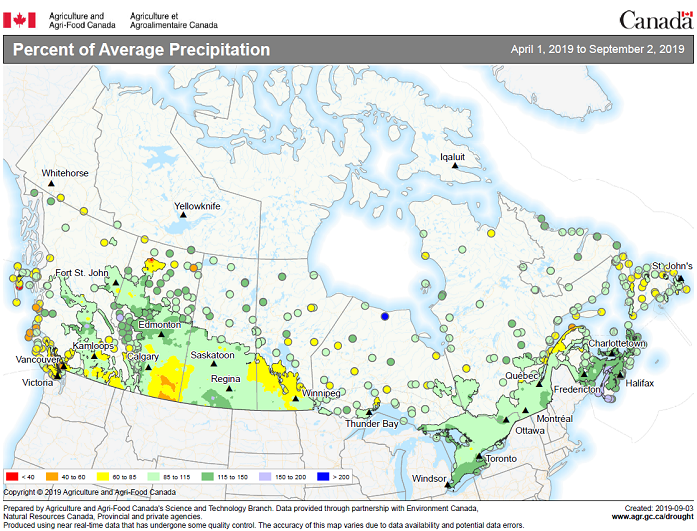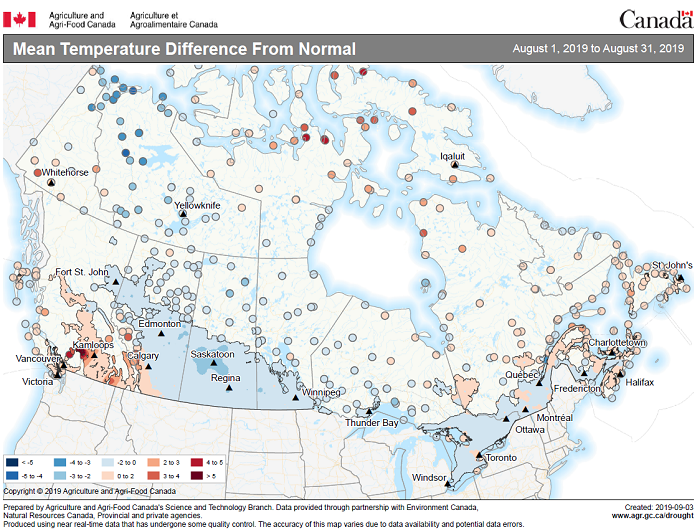Model-based principal field crop estimates, August 31, 2019
Archived Content
Information identified as archived is provided for reference, research or recordkeeping purposes. It is not subject to the Government of Canada Web Standards and has not been altered or updated since it was archived. Please "contact us" to request a format other than those available.
Released: 2019-09-12
Dry conditions since the beginning of the crop growing season have persisted in most of Manitoba and southern Alberta. Moisture conditions were better in the other regions of the Prairies (see Map 1), and this ultimately helped improve yield and production estimates.
A cool wet spring in Eastern Canada delayed corn and soybean planting. Average to above average rain through part of the crop growing season (see Map 2), coupled with average to below average temperatures, have limited yield and production.
According to estimates, national production is expected to increase in 2019 for spring wheat, corn for grain, barley, dry field peas, oats, dry beans, lentils, flaxseed, and fall rye compared with 2018.
At the same time, production is expected to decrease for canola, soybeans, durum wheat, winter wheat, chick peas, mustard seed, canary seed, and sunflowers.
Spring wheat production is expected to rise
Using a model-based methodology, Agriculture and Agri-Food Canada and Statistics Canada estimate that total wheat production in Canada will increase 0.9% compared with 2018 to 32.5 million tonnes in 2019. A 1.9% increase in total wheat yield to 49.4 bushels per acre in 2019 is expected to offset a 1.1% decrease in harvested area.
According to estimates, spring wheat production is expected to increase 7.6% from 2018 to 25.8 million tonnes. Although the spring wheat yield is expected to decrease 0.4% to 51.2 bushels per acre, a 7.9% increase in harvested area is expected to offset the decline in yield.
Durum wheat production for 2019 is expected to be 5.0 million tonnes, down 13.0% from 2018.
Winter wheat production for 2019 is expected to decline 30.7% compared with 2018 to 1.7 million tonnes, as a result of a 25.1% decrease in harvested area and a 7.4% decline in yield to 69.6 bushels per acre. Cooler temperatures in mid-to-late summer (see map 2) were a concern, but warmer temperatures during the critical growing period from mid-July to mid-August likely reversed some of the downward pressure on yields.
Canola production is expected to decline despite higher yields
According to estimates, canola production is expected to decline 4.8% from 2018 to 19.4 million tonnes in 2019. Although canola yield is expected to increase 3.8% to 41.3 bushels per acre, an 8.3% decline in harvested area could bring national production down 4.8% in 2019.
Dry weather across the Prairies was a concern earlier this summer. However, much needed rain, along with average to slightly below average temperatures, increased the canola yield estimates from earlier forecasts.
Corn for grain is expected to increase on larger harvested area
At the national level, corn for grain production is expected to rise 1.6% from 2018 to 14.1 million tonnes in 2019. An estimated 2.3% increase in harvested area in 2019 could offset a 0.6% decline in yield to 153.6 bushels per acre.
A cool wet spring delayed planting in Eastern Canada, where 87% of Canada's corn is grown. This region experienced a mean temperature difference from normal of 0 to -2 degrees Celsius during the growing period, which put downward pressure on yields.
Soybean production is expected to decline on lower yield and a reduced harvested area
Soybean yield is expected to decline 1.2% to 42.0 bushels per acre at the national level in 2019 compared with 2018. The lower yield, combined with a 9.7% decline in harvested area to 5.7 million harvested acres, is expected to result in a 10.8% annual production decline to 6.5 million tonnes in 2019.
Ontario is expected to produce 3.9 million tonnes of soybeans, or 60.1% of the national production, in 2019. Manitoba is second at 1.3 million tonnes, or 20.7% of total soybean production, while Quebec ranks third at 1.1 million tonnes, or 16.2%.
Note to readers
Model-based principal field crop estimates are calculated according to an approach developed by Statistics Canada in close partnership with Agriculture and Agri-Food Canada. These yield estimates are based on a model that incorporates coarse resolution satellite data from Statistics Canada's Crop Condition Assessment Program, data from Statistics Canada's field crop reporting series, and agroclimatic data.
A methodology report describing the original yield model used at Statistics Canada is available online.
Starting in 2019, an extended yield model based on parcel level crop insurance data received from Manitoba Agriculture Services Corporation was used for Manitoba. For more information regarding the extended yield model, please visit An Integrated Crop Yield Model Using Remote Sensing, Agroclimatic Data and Crop Insurance Data.
Production estimates for Quebec, Ontario, Manitoba, Saskatchewan and Alberta are calculated using the model-based yields as of August 31, multiplied by the reported harvested area from the July Farm Survey of the field crop reporting series. Estimates for Prince Edward Island, Nova Scotia, New Brunswick, and British Columbia are carried forward from the July estimates of production of principal field crops.
Final crop production estimates for the current year will be released on December 6.
Contact information
For more information, or to enquire about the concepts, methods or data quality of this release, contact us (toll-free 1-800-263-1136; 514-283-8300; STATCAN.infostats-infostats.STATCAN@canada.ca) or Media Relations (613-951-4636; STATCAN.mediahotline-ligneinfomedias.STATCAN@canada.ca).
- Date modified:



